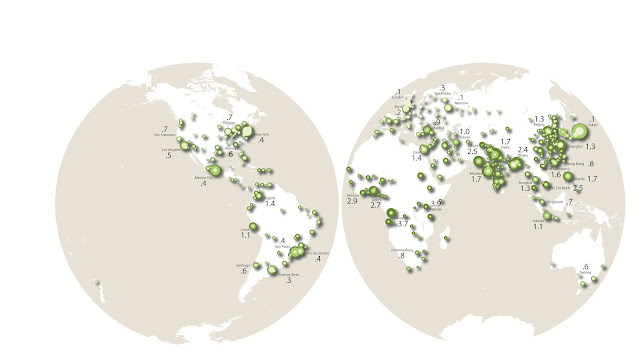And this
Curiosity, a magnificent and sophisticated robot landed in Mars this Monday 6 August, 2012. Of course I could not but bring my personal contribution to these flows of articles and reactions of this rover.
Curiosity is looking to explore the potential of supported life and transformation from a wet and warm planet into a dry and cold one.
In many ways imagination, fiction, and myth are more active in our image of Martian environments than scientific fact. The way in which we imagine Martian landscape and view our relationship to it explains this excitement for
Curiosity's landing.
Suggested article: (among many others from The Washington Post)
A Mobile Laboratory on Mars ||
The Washington Post
For a large number of observers,
Curiosity's exploration might be offering us new perspectives of understanding not only Martian landscape's evolution as well as the Earth's one.
 |
© NASA, JPL, Caltech. | Alberto Cuadra/The Washington Post
Originally appeared on The Washington Post |
First,
Curiosity landed in the north-west quadrant of
Gale Crater which geology shows up that
Gale might have been full of water for hundreds of millions of years,
Lisa Grossman reports in the
New Scientist.
As the same
Lisa Grossman reports,
Curiosity's
eventual destination is Aeolis Mons, also known as Mount Sharp. Aeolis Mons is a 5-kilometer-high mountain in the crater's centre.
 |
Curiosity's Possible itinerary.
Originally appeared on New Scientist |
Why
Aeolis Mons? As described on
The Washington Post:
This 90-mile depression was chosen by NASA mainly because of the mountain of layered materials in the middle, Aeolis Mons. On Earth, this mound would be mountain three miles high. Studies from orbit have revealed that the layers have different minerals depending on their height. Near the bottom of the mound are clay minerals. Higher there are layers with sulfur and oxygen-bearing minerals. Flowing water appears to have carved channels in both the mound and the crater wall.
In short, this mountain might have collected important data on this landscape. First water's trace. It is reported that Mars contains clays and minerals and both ingredients are evidence of water. This evidence of water then embraces multiple possibilities… at least, speculations of life's trace on this intriguing landscape. Needless to repeat that the soil is a memory bank of pattern change, adaptability, and of impact of climate evolution on landscape. As
Geoff Manaugh clearly writes,
Mars is an alien landscape, then, in everything but name.
Suggested article: BLDG BLOG |
Mars Bungalow and the Prison of Simulation || also on book format: The
BLDG BLOG Book, Chronicle Books, 2009.
And we will be seeing, during
Curiosity's two-year exploration that even the smallest things, the smallest discovery that describe Mars' landscape pattern evolution will be put into focus with a highly excitement.
Suggested article: Lisa Grossman |
Where next? Curiosity's scientific priorities on Mars ||
New Scientist
So
Curiosity. 900 kilograms, a length of 3 meters and a radioactive-plutonium-238 battery capable of
allowing the robot to rove day and night.
Suggested article: Adam Mann |
Laser, Cameras and Particule Detectors: Mars Rover's Super High-Tech Science Gear ||
Wired US
This Rover, the
New Scientist describes, is equipped with a camera, also known as
ChemCam, that will be providing color images and video footage.
This camera also contains a laser that will be analysing the composition of rocks. According to
Marc S. Kaufman of
The Washington Post, this camera will be able to offer
images and videos of a type and quality never seen before.
Suggested article: Marc S. Kaufman |
With NASA Mars rover Curiosity safely on surface, time to take inventory ||
The Washington Post
 |
ChemCam Mast Unit | CNES
Originally appeared on CNES. |
 |
ChemCam | CNES
Originally appeared on CNES. |
The laser will be able to measure signals that, then, will be identifying and analysing rocks and soil…
 |
ChemCam: How it functions | © CEA
Originally appeared on Wired US. Another but similar image can be found on CNES.
> "The ChemCam, which is announced to have been created by a French laboratory is equipped with a laser beam to shoot rocks and characterise sample of rocks and soils. A spectograph will then analyze the vapor, determining the composition and chemistry of the rocks." [ Wired US and CNES] |
Suggested article: in French:
CNES-Mission d'exploration planétaire ||
L'instrument chemcam du Rover MSL
An environmental monitoring station will be recording daily weather. Sample analysis at Mars (also known as SAM) instrument will be searching organic compounds and hints of life. A radiation assessment detector will calculate radiation hazard to any microbial life and future human missions. Other camera are installed in the robotic arm.
 |
ChemCam | Wired US
Originally appeared Wired US.
> "Situated on Curiosity's head, ChemCam can shoot up to 23 feet and should provide unprecedented detail about minerals on the Martian surface." [Wired US] |
A spectrometer completes this robotic arm. Both camera and spectrometer will be providing close-up views of rocks and characterising samples in rock and soil. A Mars descent imager will be producing high-resolution views of landing site. A neutron detector will be looking for possibly liquid water, ice and hydrated minerals.
Suggested article: Duncan Geere |
Glory comes hand-in-hand with tragedy for Mars missions ||
Wired UK
It is also equipped with a Chemistry and Mineralogy (or CheMin) instrument to searching for mineral clues of habitability. This CheMin, then, will be bombarding the sample with X-Rays to determine its composition,
Wired US writes. A very sophisticated robot to explore a landscape mined data as well as resources of Martian environment.
Video originally appeared on
NASA's Curiosity rover successfully touches down on Mars ||
The Washington Post




































